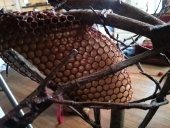Hi Valerie --
There are step-by-step instructions - but they are not exactly quick or easy. One goal I had when I wrote The Thinking Beekeeper was to make it as clear as possible, and offer broad insights that let the aspiring beekeeper build upon their knowledge as they learn. Having a Bee Buddy or a mentor is also a good way to learn.
I am often asked about whether one can "start small" - and the answer is yes, but by small I mean by having only one hive, as opposed to multiples.
The size of the hive itself must be adequate for the bees to build a home that will contain the size of brood nest they will need and allow them to store the amount of honey that they need in order to survive a winter in the geographical location they are in.
It seems as if a good size is in the neighborhood of 4 feet, or 30 top bars. Smaller hives can work in very warm climates, but may not allow the bees to build up enough in a cold climate. If I had to suggest a minimum hive size, I would say 24 bars is probably as small as makes sense. So that's what's mean by starting small.
But there is an advantage to starting with two (or more) hives - several advantages really. One is: how much more you will learn with two hives - it's not just twice as much, it's probably 10 times as much! It's unbelievable how different 2 hives, even in the same location, can be.
Another advantage is that if you have a problem in one hive, you may find that you have the resources to fix it in the other hive. The best example of this is the ability of the bees to make a new queen so long as they have a bar of brood comb containing "open larvae." The bees are able to take a worker bee larva, turn the wax cell, rebuilding it a bit to make it vertical, and then they feed that bee a diet of royal jelly, as they would a queen bee, and that worker bee will turn into a queen. Voila! Bee Magic!
So if you'd really like to start small - just go with one hive. If you'd like a little insurance, go with two!

-- Christy







